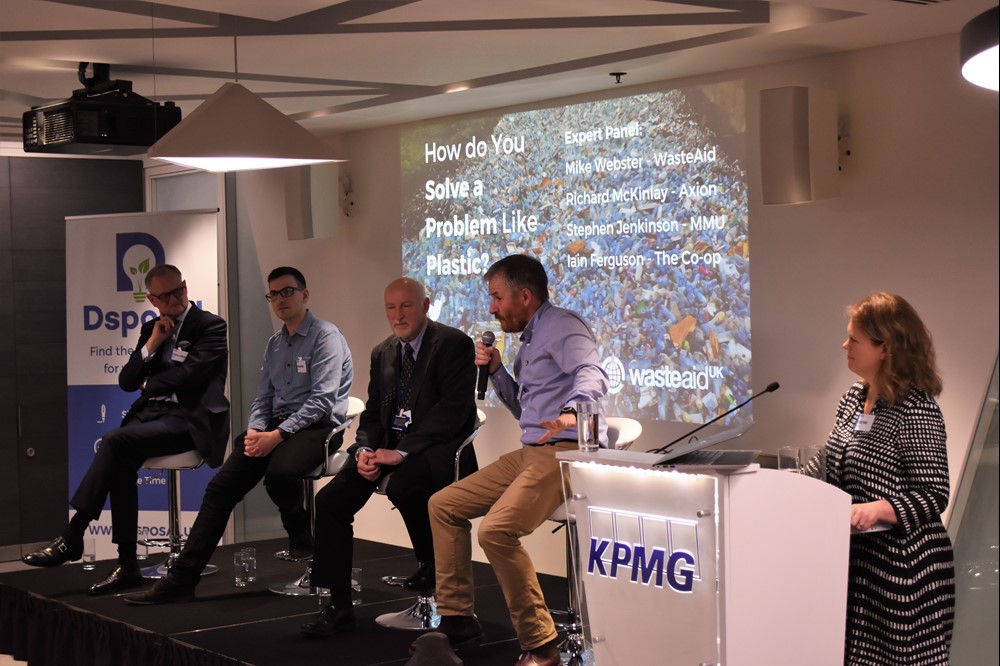With so much in the news over the past few months about plastic pollution and ‘solutions’ ranging from the sensible to the downright nonsensical I thought I’d try to explore in detail some of the most popular proposals and why they may not be the right way to go. I think it’s brilliant that public opinion is swaying towards the sustainable, but if we don’t apply a holistic approach to finding these solutions we risk replacing one issue with another issue without improving things, hence the use of the old adage since the road to hell is paved with good intentions.
The reactions have reminded me of a situation we had whilst cycle touring in North America in 2015. We’d tried to cycle over a 10,000ft mountain, in snow, without the proper clothing. Tom had ended up on the verge of hypothermia and still has nerve damage in his little finger caused by the extreme cold. He took to a Facebook group we’re members of for cycle tourers to ask what he’d done wrong with his layering and listed the different items he’d been wearing on the climb (and descent) which included a cotton shirt. The amount of responses Tom got chiding him for the cotton shirt was unexpected and ranged from the well-explained science behind why that item was a poor choice to simply “COTTON IS THE DEVIL’S FABRIC!!!!” and “Never, ever, ever, ever, ever, ever, ever, ever, ever, ever, ever, EVER wear cotton.” The similarity is that while cotton was absolutely a terrible choice for this occasion (it doesn’t wick sweat away and once it’s wet it just sucks the warmth out of you) cotton is a brilliant choice for other climates or situations. In fact, the reason we had the cotton shirts was because we’d been cycling through the desert just a couple of weeks before and in the dry heat of the Mojave a light cotton shirt offers excellent sun protection and is in many ways the perfect material. Which is to say that the material itself is not necessarily the issue, but the application.
 So, following on from our launch event on the 15th March 2018 which brought together a panel of industry experts to explore ‘how do we solve a problem like plastic?’ I’ve compiled a number of popular ‘solutions’ that I think need further scrutiny.
So, following on from our launch event on the 15th March 2018 which brought together a panel of industry experts to explore ‘how do we solve a problem like plastic?’ I’ve compiled a number of popular ‘solutions’ that I think need further scrutiny.
1) We need to ban all single use plastic.
I know that sounds good and it’s what Greenpeace and Friends of the Earth are telling you to campaign for but let’s look at this in detail. First off, it’s not even clear what’s meant by single use plastic. If something is used for a single purpose, but that purpose lasts for 10 years or more is that still single use? Take the domes at the Eden Project or the roof of Manchester Victoria Station which are both made of ETFE (Ethylene tetrafluoroethylene). I don’t think many would argue that using plastics in this way should be banned since it’s widely regarded as an environmentally friendly building material. I’m not just saying this to be pedantic, I think it’s really important to be clear on the message and I just don’t think the term ‘single-use plastic’ is fit for purpose. There’s also many examples of single use items where plastic is arguably the best material, think the sterile packaging that needles come in for example. Undoubtedly there’s a whole host of things made from plastic, some of them single use, which shouldn’t be, but I’d argue the issue is not so much if an item is single use, but if that item actually serves a real purpose. If it doesn’t then plastic or otherwise we probably shouldn’t be using any of the Earth’s resources bringing it into the world. Two examples that spring to mind are a ‘novelty’ inflatable zimmer frame and a unicorn horn for cats – sure they may result in a giggle, but unless the joke is so good that it spawns a family legend that is passed down the next 6 generations, then the joke lasts for 5 minutes whilst the useless remnants of that item will still remain in the world in centuries to come. Next to these a plastic drink bottle or the vacuum packaging extending the life of a steak seem less frivolous and do at least serve a function.
2) We need plastic-free supermarkets.
There’s been a number of petitions going around about this, not to mention the supermarket Iceland coming out and saying it will get rid of all plastic packaging from its own label products by 2023, but this is a complex issue that I don’t think will be solved by such a simplistic solution. Plastic packaging of certain foods dramatically increases that food’s shelf life and the environmental cost of food production is around 3 times higher than the environmental cost of the packaging and the UN estimates that around a third of all food produced never makes it to our forks. The recent report by Zero Waste Europe, Friends of the Earth and Rethink Plastic (Unwrapped How Throwaway Plastic Is Failing to Solve Europe’s Food Waste Problem (And What We Need To Do Instead)) stating that because both household food waste and plastic packaging waste in the EU have increased since the 1950s that proves that plastic can’t contribute to reducing food waste is the kind of terrible ‘science’ we really could do without.
I’m no scientist, but I think what that shows is correlation, not causation. Since the 1950’s the percentage of people who went to university has also increased, but I don’t think we can point the finger at that being the cause of more plastic pollution. Personally, I think the reason we have both more food waste and more plastic waste is that since the fifties we’ve become an increasingly consumerist society. There is of course a bigger problem here and our food system is horribly inefficient and riddled with inequality, but unpackaging all foods is only going to exacerbate these issues. Obviously, we can all give examples of items that are over-packaged or don’t benefit from packaging and in those cases, we absolutely should be pushing retailers and manufacturers to cut down on unnecessary packaging. But please let’s not throw the baby out with the bathwater unless we are talking about radically overhauling our entire food system and diet which would mean not just unpackaging those peppers, cucumbers and tomatoes but actually only eating them when they are in season and we can wave good bye to avocados, mangoes and a whole host of other produce. In some of the examples of plastic-free aisles or stores they have just replaced traditional plastic with bioplastics which leads me on to…
3) We can solve our plastic woes by swapping them all with bioplastics.
No, we can’t. Most bioplastics are made from plants, which have to be grown. If we were to replace all the plastics we currently use with bioplastics, even just the packaging, I think we’d quickly run out of land (not to mention the associated environmental costs of growing all those plants and turning them into plastics). Plus, and here’s the thing many people don’t realise about bioplastics, if the plant material is engineered to replicate current plastics it does just that. It replicates all the qualities of that plastic including being incredibly hard to break down and potentially just as environmentally damaging as ‘normal’ plastic. To Iceland’s credit they acknowledge that they can’t just replace their current plastic packaging with bioplastics and that they are looking at various different materials. Now that’s not to say that all bioplastics bad, there are packaging materials being made from various natural organisms or from by-products which do offer more environmentally sound alternatives (check out Ecovative who make packaging out of mycelium) but we can’t expect to just replace all plastic with bioplastic and bioplastic straw, bag, cup, wrappper with all the same characteristics of a traditional plastic can still choke wildlife and take centuries to breakdown.
4) We should just implement a deposit return scheme (DRS) on recyclable items like they have in Scandinavia.
Well there’s definitely some benefits to DRS like improving recycling rates and the quality of the recycled material, but the way most of these systems work is that people are required to take their recycling to special reverse vending machines where they pay in their recycling and the machine detects what the items are and returns the deposits usually in the form of a coupon or voucher. The issue is that these schemes tend to target good quality materials (like bottles and cans) which have a value and that in taking them out of the local authority kerbside collections also takes that value out of the potential revenue the local authorities can get for these materials. Also, what about in rural areas that maybe don’t have the economies of scale to make it worth implementing a vending machine for those communities – how do those people return their items if they don’t have their own transport? That’s not to say it’s a terrible idea, but just that there’s consequences that need to be considered and taken into account, especially with the continued regime of continually cutting local authority budgets.
5) We should revert to using reusable items – milk in glass bottles, water bottles, coffee cups, shopping bags.
Again, on the face of it this seems like a no brainer. I myself have a reusable KeepCup for my coffee, a water bottle (well I have a few actually as I cycle) and a multitude of reusable shopping bags from cotton to non-woven PP (Polypropylene) to bags for life. But when we look in detail at the environmental impact of these things the sums are not so clearly in their favour. The old HDPE (High-density polyethylene) shopping bags that you now get charged 5p for in comparison to their paper, cotton or bag for life counterpart actually stand up very well when you look at the environmental cost of the whole life cycle. This table is from an Environment Agency study (Life cycle assessment of supermarket carrier bags: a review of the bags available in 2006).
| Type of Carrier | HDPE bag (No secondary reuse) | HDPE bag (40.3% reused as bin liners) | HDPE bag (100% reused as bin liners) | HDPE bag (used 3 times) |
| Paper bag | 3 | 4 | 7 | 9 |
| LDPE bag (e.g. bag for life) | 4 | 5 | 9 | 12 |
| Non-woven PP bag (e.g. larger, sturdier shopping bags) | 11 | 14 | 26 | 33 |
| Cotton bag | 131 | 173 | 327 | 393 |
And similar studies have been done on cups in cafes – the reusable cups, be they ceramic, metal or plastic have to be used between 20 and 100 times to outperform the greenhouse gas emissions of a single use cup and once you take into account the washing of the reusable cups and the environmental cost that has, then on some measures you need to reuse the cup over 1000 times. Unfortunately, the fact that we lack the recycling binfrastructure and incentives to ensure that these items don’t end up littered, in landfill or shipped abroad to be ‘dealt with’ elsewhere puts these disposable items on the hitlist. That’s not to say that choosing reusable isn’t the right thing to do, but we should each choose our reusable items carefully ensuring we use them for as long as possible, certainly years, whilst minimising the amount of hot water and soap we use to clean them. And with items we are unlikely to reuse hundreds of times then using a disposable version is preferable especially if we can put in place the ability to recycle or compost it at the end of its use.
Don't Shoot the Messenger
In exploring these proposed solutions my intention is not to say that they’re bad and we should do nothing, but that these are complex problems which require investigation and consideration to ensure that the measures we put in place are fit for purpose, not purely forged in the fires of public opinion with little or no data or science behind them. The recent report (Eliminating avoidable plastic waste by 2042: a use-based approach to decision and policy making) that was published to coincide with the Resourcing the Future conference in June proposed a really interesting new way to approach plastics suggesting a ‘use phase’ model where items were classed by how long they were in use for and in some cases size as well (Eliminating Avoidable Plastic). This to me is a much better classification than ‘single use’ as it groups together items across industries and sectors into their useful life as generally the characteristics, impacts and cost of items in these use phases are similar, regardless of application, so when designing measures to combat plastic pollution they can be better targeted and assessed if using this framework. We must take the whole life cycle of the item into consideration when looking at the environmental cost and suitability of a particular material, but before that maybe the most fundamental question we should be asking is ‘does this item need to exist?’ and if the answer is no, then no matter what material you choose it’s not the right choice for the planet.


